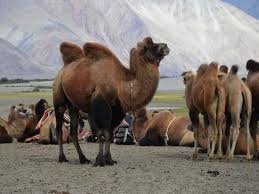New Delhi, Aug 4, 2025 : After nearly a decade of research and field trials, the Indian Army has officially inducted Bactrian camels—hardy, double-humped animals native to Ladakh—for logistics and patrol duties in high-altitude areas.
The Defence Institute of High Altitude Research (DIHAR), a DRDO lab in Leh, recently handed over 14 trained Bactrian camels, along with standard operating procedures and health records, to the Army’s 14 Corps. These camels will support operations in remote posts, where traditional transport and even drones face limitations.
Though Ladakh now has an extensive road network, the final stretch to forward positions still relies on porters and pack animals. Drones and mechanical mules are being explored, but their effectiveness drops significantly in harsh weather and rugged terrain. In contrast, animals like Bactrian camels can navigate these conditions with resilience and without the vulnerability of electronic systems to enemy jamming or harsh climates.
Research on Bactrian camels began in 2016, jointly undertaken by DIHAR and the Army’s Remount and Veterinary Corps. The studies focused on physical endurance, behavioral training, and adaptability to battlefield conditions such as gunfire, smoke, and loud blasts.
The trials proved successful: Bactrian camels, adapted to hypoxia and sub-zero temperatures, can carry loads of 150–200 kg up to 14,000 feet—far more than the 60–80 kg typically handled by mules and ponies. They also require less feed and care, making them more efficient in high-altitude deployment.
For comparison, DIHAR even brought desert camels from Rajasthan to Ladakh. While desert camels serve effectively in Rajasthan and Gujarat under the Border Security Force, the Bactrian variety proved far superior for mountainous terrain.
Scientifically known as Camelus bactrianus, these camels once plied the Silk Route, connecting Central Asia with Ladakh and Tibet. When trade declined, many were left behind and adapted to Ladakh’s wilderness. Today, with only a few hundred remaining—mostly in Nubra Valley, where they’re used for tourism—they’re considered an endangered species.
The Indo-Tibetan Border Police is also studying the viability of using Bactrian camels for high-altitude operations, suggesting a broader adoption across India’s northern frontiers.



















